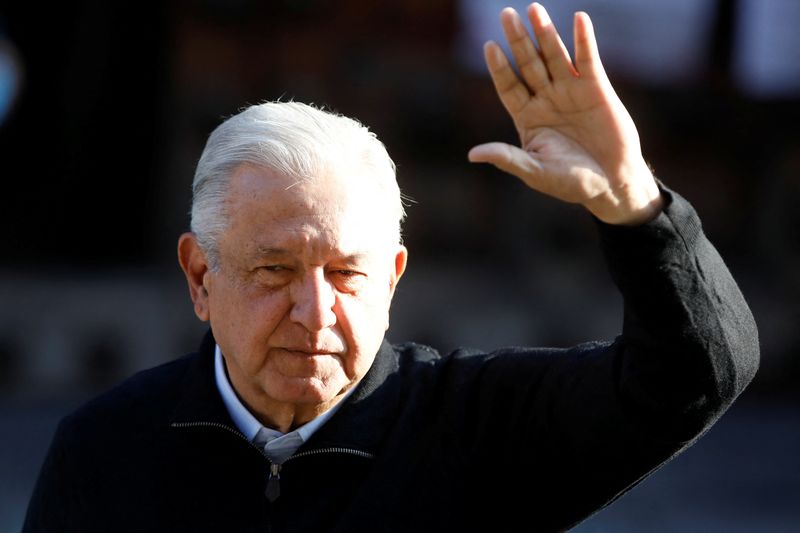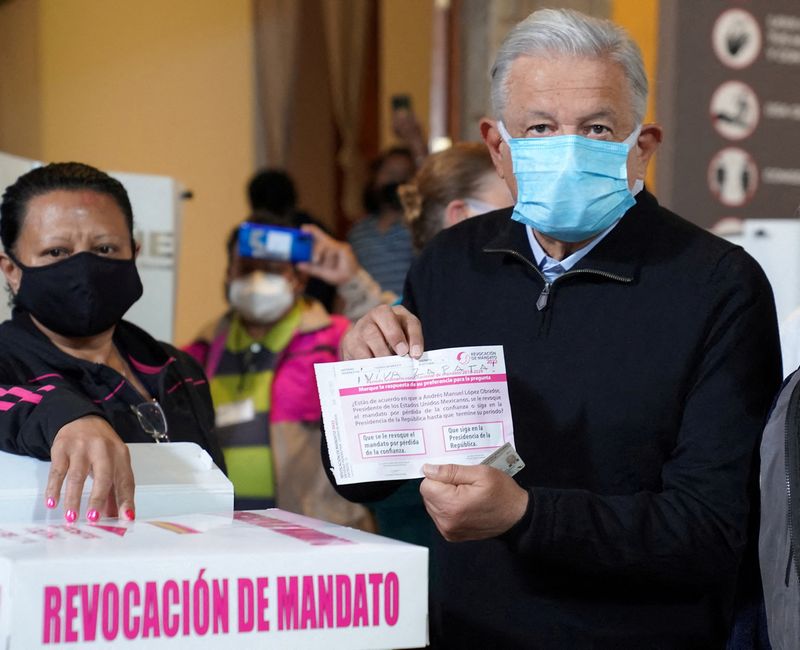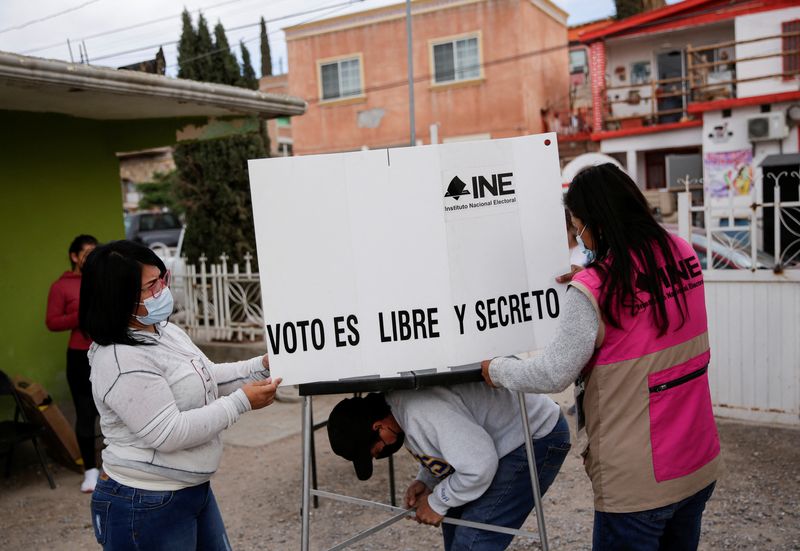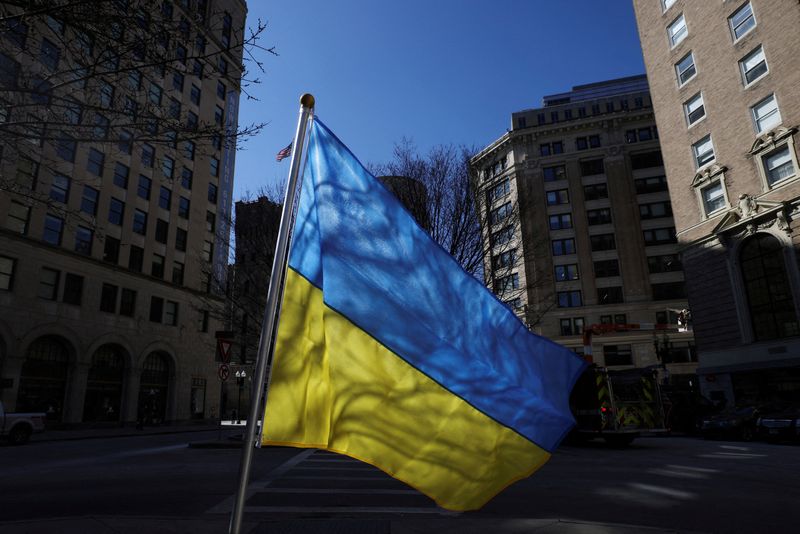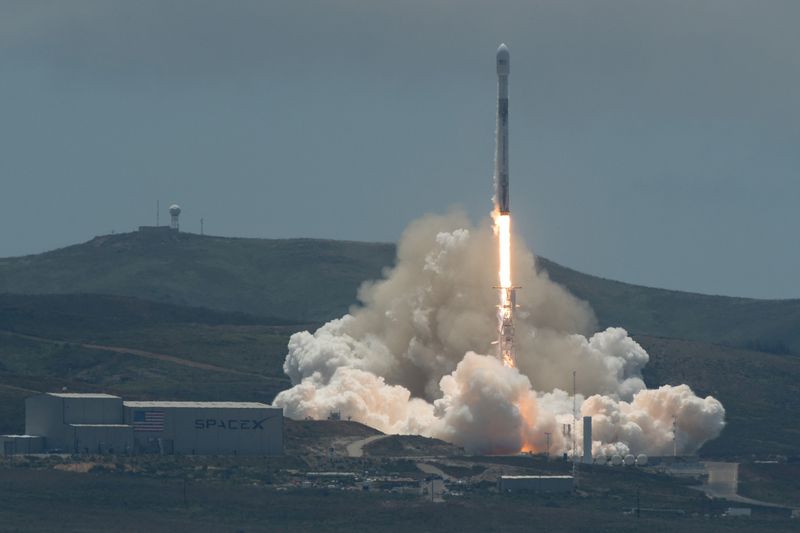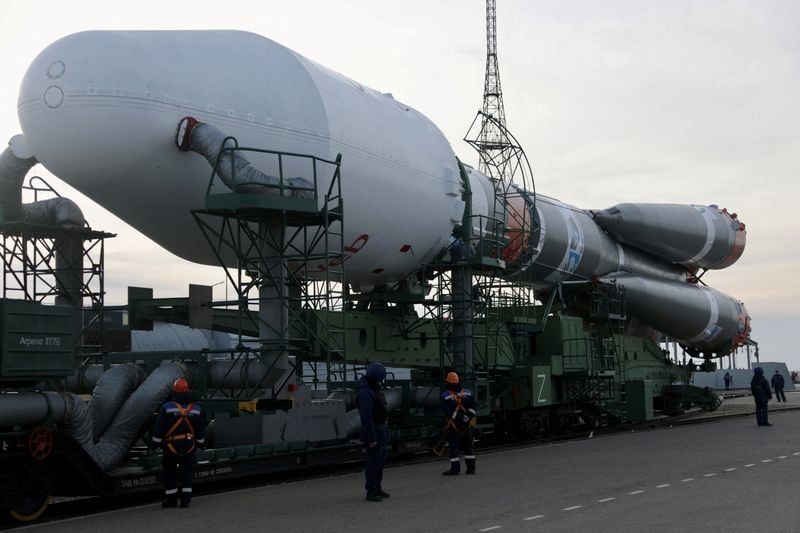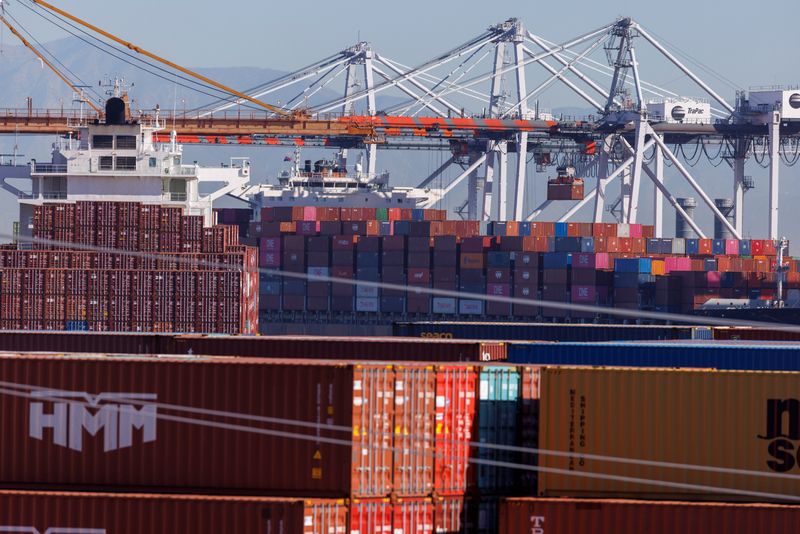HELSINKI – Finnish tyre maker Nokian Tyres said on Monday new sanctions imposed by the European Union (EU) on Russia will have a significant impact on its production.
The sanctions, announced on Saturday, ban the import of tyres from Russia, Nokian said, and will affect the company’s ability to sell tyres both in Russia and in the EU, specifically in Central Europe.
The sanctions will also prohibit the export of certain raw materials from the EU to Russia and limit transportation from and to Russia, the company added.
In 2021, Russia accounted for approximately a fifth of the company’s net sales, with approximately 80% of its passenger car tyres produced in the country. Around half of the raw material used to produce tyres in Russia came from outside the country, Nokian Tyres said.
“Raw material availability and its logistics will have a significant impact on the company’s capability to continue production in Russia,” it said in a statement.
The company said it would expedite plans to invest in new production capacity in Europe, while also boosting capacity at its existing factories in Finland and the United States.
Ad: Save every day with Amazon Deals: Check out today's daily deals on Amazon.
“The Heavy Tyres business of Nokian Tyres plc is not impacted by the ban to import tyres from Russia to the EU, as all Nokian Tyres’ heavy tyres are produced in Finland,” it said.
(Reporting by Boleslaw Lasocki in Gdansk and Anne Kauranen in Helsinki; editing by Uttaresh.V, Kirsten Donovan)
Orlando cracks list of world’s top 10 busiest airports as U.S. leisure traffic soars
(Reuters) – Orlando cracked a list of the world’s top 10 busiest airports by passengers for the first time last year, as the home of the Walt Disney World and Universal Studios Florida theme parks joined mostly American hubs as soaring leisure travel underpins a recovery in traffic.
Hartsfield-Jackson Atlanta International Airport topped the rankings by passenger traffic published Monday by Airports Council International (ACI), which is based on a preliminary compilation of 2021 global data.
The report also ranked airports by cargo volumes and aircraft movements.
While the United States has seen the fastest and strongest recovery in travel, fueled by leisure trips to destinations like Florida, it still trails 2019 traffic levels.
According to FlightAware data for March 6 to 13, U.S. commercial flights were down almost 18% compared with the same period in 2019. By contrast, global traffic was down nearly 27%.
With 40.4 million passengers, Florida’s Orlando International Airport ranked seventh in 2021, just ahead of China’s Guangzhou Baiyun International Airport, and breaking into the top 10 for the first time since data was available in 1991, ACI told Reuters.
Ad: Save every day with Amazon Deals: Check out today's daily deals on Amazon.
While China remains an aviation powerhouse the country’s international borders remained closed in 2021. Domestic traffic fell due to the country’s zero-COVID policy which meant a series of outbreaks that are tiny by world standards led to strict internal travel controls, dampening demand.
A spokeswoman for the Greater Orlando Aviation Authority said the airport is expecting higher traffic in 2022 as international and business travel return in greater numbers.
The rankings “tell the story of an encouraging trend of recovery, with most of the recurrent busiest airports pre-COVID-19 back at the top,” ACI World Director General Luis Felipe de Oliveira said in a statement.
Traffic at the top 10 busiest airports in 2021 represented about 463 million passengers or almost 10% of global traffic, ACI said.
(Reporting By Allison Lampert in Montreal; Additional reporting by Jamie Freed in Sydney; Editing by Andrea Ricci)
By Michel Rose
PARIS -President Emmanuel Macron will not be able to count on French voters’ traditional anti-far right front in the final runoff and will need to step up his campaign if he is to defeat Marine Le Pen, who has successfully softened her image.
Although Macron was projected to win a better-than-expected first round score of 28%, improving on his 2017 result, Macron cannot count on victory: polls forecast a razor-thin margin of victory against Le Pen in the April 24 run-off.
In past elections at national, regional and municipal levels, left- and right-wing voters have historically united to block the far right from power, a phenomenon known as a ‘republicain front’.
While all mainstream candidates, including those of the conservative Les Republicains and Socialist party, endorsed Macron for the runoff on Sunday night, it is not clear their voters will follow. Moreover, their low single-digit scores were so pitiful that their support may carry little weight.
“Among politicians, the republican front is putting itself in motion. It remains to be seen whether voters will follow,” said Mathieu Gallard, head of research at Ipsos France.
Ad: Save every day with Amazon Deals: Check out today's daily deals on Amazon.
An Ifop poll taken outside polling stations during Sunday’s vote forecast Macron winning 51% of voter support in two weeks time, a clear indication the “republican front” is crumbling.
Complicating Macron’s task, Le Pen has largely dropped her more pugnacious anti-immigration, anti-European Union rhetoric, focusing more on cost of living issues.
Another Ifop survey in March showed that fewer than half of all French now found her “scary”.
In her speech on Sunday, she painted herself as a unifying figure, who would heal France’s “fractures” and halt the “chaos” supposedly brought about by Macron, a former banker who she said embodied the “power of money” and worked for the few.
BATTLE FOR THE LEFT
Meanwhile, Macron cannot take left-wing voters for granted.
The third-placed candidate, Jean-Luc Melenchon, urged voters not to back Le Pen, but stopped short of endorsing Macron, increasing the uncertainty as to how the projected 21% of voters who backed the far-left firebrand will cast their ballot.
Polls show many may decide to abstain.
“Macron’s politics … has strengthened the far-right,” voter Lea Druet, 27, told Reuters at Melenchon’s campaign headquarters. She voted for Macron in 2017 and said she would abstain in this month’s runoff.
Other Melenchon supporters were still unsure. “I’ll see how the next two weeks go. If the polls say 49-51, at that moment I will vote Macron,” said Guillaume Raffi, 36, a music producer from Montpellier.
Macron supporters and campaign insiders say the incumbent leader will have to spend more time campaigning on the ground than he did in the run up to the first round if he wants to counter Le Pen, who has tapped into anger against the rising cost of living and deep-seated discontent towards a distant elite.
Macron has acknowledged entering the campaign too late as he focused on dealing with the fallout from the war in Ukraine.
“In the second round, Emmanuel Macron will need to roll up his sleeves a bit more than he did for the first,” the former French ambassador to Washington, Gerard Araud, wrote on Twitter.
(Additional reporting by Layli Foroudi; Writing by Michel Rose; Editing by Daniel Wallis)
By Dave Graham
MEXICO CITY -Nine out of ten Mexicans voting on Sunday in an unprecedented recall election engineered by President Andres Manuel Lopez Obrador backed him to stay in office, underlining his domination of a polarized political agenda.
Both critics and supporters alike had viewed his victory as a foregone conclusion in a ballot that had fed speculation it could open the door to extending presidential term limits, now limited to a single six-year period.
Between 90.3% and 91.9% voters were predicted to have supported Lopez Obrador, a preliminary estimate from the National Electoral Institute (INE) showed on Sunday night.
Unleashing a string of barbs at adversaries, Lopez Obrador hailed the referendum result as “historic”, and compared his tally favorably with the number of votes won by rivals he defeated to win the presidency, and in other elections.
“We don’t have a king in Mexico,” he said in a video address. “It’s a democracy, and the people are in charge.”
A pugnacious leftist, Lopez Obrador was the architect of the first so-called ‘recall referendum’ in modern Mexico, calling it vital to confirm his democratic mandate.
Turnout in the vote was forecast at between 17% and 18.2%, INE said, well below a threshold of 40% for it to be binding, and lower than some polls.
Opposition leaders had actively discouraged supporters from voting, with many condemning the plebiscite as a propaganda exercise and a costly distraction from real problems.
Turnout had been expected to range between 16% and 25% in a poll published by newspaper El Financiero this month.
Political analysts had said Lopez Obrador would seize on the result as a personal triumph in his bid to push a constitutional change to the electricity market through Congress in the coming week, although he looks short of votes.
Lopez Obrador denies wanting to extend his term, but he used the referendum to fire up supporters and test his strength ahead of gubernatorial elections in June.
Since taking office in December 2018, Lopez Obrador has fallen short of campaign pledges to reduce violent crime and lift the economy, unsettling investors by trying to renegotiate contracts and tightening state control of natural resources.
But his successful roll-out of welfare programs and relentless daily depiction of a political narrative in which he stars as a morally upright defender of the poor against a corrupt, wealthy elite has helped buttress his popularity.
CONTENTIOUS
Many Mexicans regard the folksy Lopez Obrador as a welcome departure from previous leaders often seen as aloof from the broader population in a society that remains highly unequal.
“I want the president to continue in power,” said one of them, Guillermina Gomez, after voting in the central state of Tlaxcala.
The 60-year-old homemaker said his welfare programs had allowed her grandchildren to enroll in high school, which her meager household income had kept out of the reach of her children.
“Thanks to him we’ve received benefits that no one else has given us.”
Costing millions of dollars and heavily publicized in the capital, the referendum asked Mexicans if Lopez Obrador’s mandate should be revoked “due to loss of trust,” or he should conclude his term as scheduled on Sept. 30, 2024.
Maribel Rosas, 36, who voted for Lopez Obrador to become president in 2018, said she had cast a vote for him to be removed from office, as he was failing to help the middle class and spurring social polarisation.
“This division isn’t going to get us anywhere,” said Rosas, a resident of Mexico City who works in advertising.
The president had accused the National Electoral Institute of trying to stymie the referendum, which it denied. He quickly criticized it again after the results.
(Reporting by Dave Graham; Additional reporting by Lizbeth Diaz, Diego Ore and Laura Gottesdiener; Editing by Mark Porter and Clarence Fernandez)
By Katie Paul and Munsif Vengattil
(Reuters) – Days after the March 9 bombing of a maternity and children’s hospital in the Ukrainian city of Mariupol, comments claiming the attack never happened began flooding the queues of workers moderating Facebook and Instagram content on behalf of the apps’ owner, Meta Platforms.
The bombardment killed at least three people, including a child, Ukraine’s President Volodymyr Zelenskiy said publicly. Images of bloodied, heavily pregnant women fleeing through the rubble, their hands cradling their bellies, sparked immediate outrage worldwide.
Among the most-recognized women was Mariana Vishegirskaya, a Ukrainian fashion and beauty influencer. Photos of her navigating down a hospital stairwell in polka-dot pajamas circulated widely after the attack, captured by an Associated Press https://apnews.com/article/russia-ukraine-europe-edf7240a9d990e7e3e32f82ca351dede photographer.
Online expressions of support for the mother-to-be quickly turned to attacks on her Instagram account, according to two contractors directly moderating content from the conflict on Facebook and Instagram. They spoke to Reuters on condition of anonymity, citing non-disclosure agreements that barred them from discussing their work publicly.
The case involving the beauty influencer is just one example of how Meta’s content policies and enforcement mechanisms have enabled pro-Russian propaganda during the Ukraine invasion, the moderators told Reuters.
Russian officialdom seized on the images, setting them side-by-side against her glossy Instagram photos in an effort to persuade viewers that the attack had been faked. On state television and social media, and in the chamber of the U.N. Security Council, Moscow alleged – falsely – that Vishegirskaya had donned make-up and multiple outfits in an elaborately staged hoax orchestrated by Ukrainian forces.
Swarms of comments accusing the influencer of duplicity and being an actress appeared underneath old Instagram posts of her posed with tubes of makeup, the moderators said.
At the height of the onslaught, comments containing false allegations about the woman accounted for most of the material in one moderator’s content queue, which normally would have contained a mix of posts suspected of violating Meta’s myriad policies, the person recalled.
“The posts were vile,” and appeared to be orchestrated, the moderator told Reuters. But many were within the company’s rules, the person said, because they did not directly mention the attack. “I couldn’t do anything about them,” the moderator said.
Reuters was unable to contact Vishegirskaya.
Meta declined to comment on its handling of the activity involving Vishegirskaya, but said in a statement to Reuters that multiple teams are addressing the issue.
“We have separate, expert teams and outside partners that review misinformation and inauthentic behavior and we have been applying our policies to counter that activity forcefully throughout the war,” the statement said.
Meta policy chief Nick Clegg separately told reporters on Wednesday that the company was considering new steps to address misinformation and hoaxes from Russian government pages, without elaborating.
Russia’s Ministry of Digital Development, Communications and Mass Media and the Kremlin did not respond to requests for comment.
Representatives of Ukraine did not respond to a request for comment.
‘SPIRIT OF THE POLICY’
Based at a moderation hub of several hundred people reviewing content from Eastern Europe, the two contractors are foot soldiers in Meta’s battle to police content from the conflict. They are among tens of thousands of low-paid workers at outsourcing firms around the world that Meta contracts to enforce its rules.
The tech giant has sought to position itself as a responsible steward of online speech during the invasion, which Russia calls a “special operation” to disarm and “denazify” its neighbor.
Just a few days into the war, Meta imposed restrictions on Russian state media and took down a small network of coordinated fake accounts that it said were trying to undermine trust in the Ukrainian government.
It later said it had pulled down another Russia-based network that was falsely reporting people for violations like hate speech or bullying, while beating back attempts by previously disabled networks to return to the platform.
Meanwhile, the company attempted to carve out space for users in the region to express their anger over Russia’s invasion and to issue calls to arms in ways Meta normally would not permit.
In Ukraine and 11 other countries across Eastern Europe and the Caucasus, it created a series of temporary “spirit of the policy” exemptions to its rules barring hate speech, violent threats and more; the changes were intended to honor the general principles of those policies rather than their literal wording, according to Meta instructions to moderators seen by Reuters.
For example, it permitted “dehumanizing speech against Russian soldiers” and calls for death to Russian President Vladimir Putin and his ally Belarusian President Alexander Lukashenko, unless those calls were considered credible or contained additional targets, according to the instructions viewed by Reuters.
The changes became a flashpoint for Meta as it navigated pressures both inside the company and from Moscow, which opened a criminal case into the firm after a March 10 Reuters report made the carve-outs public. Russia also banned Facebook and Instagram inside its borders, with a court accusing Meta of “extremist activity.”
Meta walked back elements of the exceptions after the Reuters report. It first limited them to Ukraine alone and then canceled one altogether, according to documents reviewed by Reuters, Meta’s public statements, and interviews with two Meta staffers, the two moderators in Europe and a third moderator who handles English-language content in another region who had seen the advisories.
The documents offer a rare lens into how Meta interprets its policies, called community standards. The company says its system is neutral and rule-based.
Critics say it is often reactive, driven as much by business considerations and news cycles as by principle. It’s a complaint that has dogged Meta in other global conflicts including Myanmar, Syria and Ethiopia. Social media researchers say the approach allows the company to escape accountability for how its policies affect the 3.6 billion users of its services.
The shifting guidance over Ukraine has generated confusion and frustration for moderators, who say they have 90 seconds on average to decide whether a given post violates policy, as first reported by the New York Times. Reuters independently confirmed such frustrations with three moderators.
After Reuters reported the exemptions on March 10, Meta policy chief Nick Clegg said in a statement the next day that Meta would allow such speech only in Ukraine.
Two days later, Clegg told employees the company was reversing altogether the exemption that had allowed users to call for the deaths of Putin and Lukashenko, according to a March 13 internal company post seen by Reuters.
At the end of March, the company extended the remaining Ukraine-only exemptions through April 30, the documents show. Reuters is the first to report this extension, which allows Ukrainians to continue engaging in certain types of violent and dehumanizing speech that normally would be off-limits.
Inside the company, writing on an internal social platform, some Meta employees expressed frustration that Facebook was allowing Ukrainians to make statements that would have been deemed out of bounds for users posting about previous conflicts in the Middle East and other parts of the world, according to copies of the messages viewed by Reuters.
“Seems this policy is saying hate speech and violence is ok if it is targeting the ‘right’ people,” one employee wrote, one of 900 comments on a post about the changes.
Meanwhile, Meta gave moderators no guidance to enhance their ability to disable posts promoting false narratives about Russia’s invasion, like denials that civilian deaths have occurred, the people told Reuters.
The company declined to comment on its guidance to moderators.
DENYING VIOLENT TRAGEDIES
In theory, Meta did have a rule that should have enabled moderators to address the mobs of commenters directing baseless vitriol at Vishegirskaya, the pregnant beauty influencer. She survived the Mariupol hospital bombing and delivered her baby, the Associated Press https://apnews.com/article/russia-ukraine-health-europe-bombings-259ec00f1a6c426603827985dac3a3e9 reported.
Meta’s harassment policy prohibits users from “posting content about a violent tragedy, or victims of violent tragedies that include claims that a violent tragedy did not occur,” according to the Community Standards published on its website. It cited that rule when it removed posts by the Russian Embassy in London that had pushed false claims about the Mariupol bombing following the March 9 attack.
But because the rule is narrowly defined, two of the moderators said, it could be used only sparingly to battle the online hate campaign against the beauty influencer that followed.
Posts that explicitly alleged that the bombing was staged were eligible for removal, but comments such as “you’re such a good actress” were considered too vague and had to stay up, even when the subtext was clear, they said.
Guidance from Meta enabling commenters to consider context and enforce the spirit of that policy could have helped, they added.
Meta declined to comment on whether the rule applied to the comments on Vishegirskaya’s account.
At the same time, even explicit posts proved elusive to Meta’s enforcement systems.
A week after the bombing, versions of the Russian Embassy posts were still circulating on at least eight official Russian accounts on Facebook, including its embassies in Denmark, Mexico and Japan, according to an Israeli watchdog organization, FakeReporter.
One showed a red “fake” label laid over the Associated Press photos of Mariupol, with text claiming the attack on Vishegirskaya was a hoax, and pointing readers to “more than 500 comments from real users” on her Instagram account condemning her for participating in the alleged ruse.
Meta removed those posts on March 16, hours after Reuters asked the company about them, a spokesperson confirmed. Meta declined to comment on why the posts had evaded its own detection systems.
The following day, on March 17, Meta designated Vishegirskaya an “involuntary public person,” which meant moderators could finally start deleting the comments under the company’s bullying and harassment policy, they told Reuters.
But the change, they said, came too late. The flow of posts related to the woman had already slowed to a trickle.
(Reporting by Katie Paul in Palo Alto and Munsif Vengattil in New Delhi; Additional reporting by Paresh Dave in Oakland, and Dasha Afanasieva and Mark Trevelyan in London; Editing by Kenneth Li and Marla Dickerson)
By Asha Sistla
(Reuters) – Gold prices slipped in range-bound trading on Monday as surging Treasury yields boosted the dollar and countered fresh concerns about the war in Ukraine, while palladium extended gains fuelled by London’s decision to block trading of the metal from Russia.
Spot gold was down 0.2% at $1,941.95 per ounce, as of 0452 GMT, after hitting a more than one-week high of $1,949.32 earlier in the day. U.S. gold futures were flat at $1,945.70.
“Gold is still trading sideways and that reflects the conflicting currents that we’re looking at. There’s still real concern about the geopolitical outlook and the potential for escalation in Ukraine,” said Michael McCarthy, chief strategy officer at Tiger Brokers, Australia.
“At the same time, a stronger U.S. dollar and potential for higher interest rates around the globe are keeping a lid on enthusiasm for gold.”
The U.S. dollar index was up after topping 100 for the first time in nearly two years on Friday, bolstered by prospects of aggressive rate hikes by the U.S. Federal Reserve to contain soaring inflation. [USD/]
A stronger dollar makes gold less attractive for other currency holders.
The benchmark 10-year yield added another seven basis points to hit a more than three-year high of 2.77%, as the Fed readies to cut its asset holdings and move interest rates sharply higher. [US/]
Higher U.S. interest rates and yields increase the opportunity cost of holding bullion, which is also used as a hedge against rising inflation.
Russian forces pounded targets in eastern Ukraine with missiles and artillery on Sunday, lending some support to the safe-haven metal.
Palladium was up 2.6% at $2,487.83 after hitting a more than two-week high earlier in the session.
The auto-catalyst metal had gained 8.6% on Friday after newly refined Russian platinum and palladium were suspended from trading in London, the metals’ biggest trade hub.
Spot silver shed 0.2% to $24.69 per ounce and platinum rose 0.5% to $979.97.
(Reporting by Asha Sistla in Bengaluru; Editing by Subhranshu Sahu)
By Caroline Valetkevitch
NEW YORK – An aggressive Federal Reserve, soaring inflation and geopolitical uncertainty from the war in Ukraine are muddying the outlook for the upcoming U.S. earnings season, leaving some strategists wary of surprises as corporate results kick off this week.
Expectations for earnings growth have largely held up in recent weeks, despite a first quarter that saw commodities prices surge after Russia invaded Ukraine, threatening to exacerbate already-high consumer prices.
Analysts expect S&P 500 earnings to have increased by about 6% in the first three months of 2022 from a year ago and forecast profit growth of about 9% for the year, forecasts in line with those at the start of the month, according to IBES data from Refinitiv.
The reporting period for S&P 500 companies begins this week with results from major banks including JPMorgan Chase on Wednesday.
Some worry, however, that a cocktail of rising prices, higher wages and tightening financial conditions may have weighed on some companies’ balance sheets or clouded expectations for the rest of the year.
“The environment is very different this quarter. There are so many things going on,” said Jack Ablin, chief investment officer at Cresset Capital Management in Chicago. “It will be fascinating to see how companies respond.”
Earnings season comes on the heels of a tumultuous quarter for asset prices that saw the S&P 500 swoon nearly 13% before paring losses in a furious rebound late last month. The index is down about 6% for the year-to-date.
Energy and other commodity prices have surged, with Brent crude futures up 32% for the year so far. The war in Ukraine has also created worries about supply and transportation problems, adding to concerns that have been building since the start of the coronavirus pandemic.
That’s led a number of companies to warn about the impact of rising raw material and other costs on margins in recent weeks, including packaged food company Conagra Brands Inc, which this month lowered its full-year profit forecast.
“I see capital more expensive, labor more expensive, commodities more expensive,” Ablin said. “Unless these firms can pass these costs along – and arguably they’ll be able to pass along some but not all… That says to me, margins have to decline.”
Tightening labor market conditions are boosting wages, another negative for companies. The Conference Board’s consumer confidence index rebounded in March amid growing labor market optimism.
In March, the Fed raised rates for the first time since 2018 and policymakers have signaled they are ready to aggressively fight the fastest consumer price growth in nearly four decades with meaty rate hikes and balance sheet runoff, leading some investors to worry that the central bank’s monetary policies may bring on a recession.
With earnings, “it’s easy to identify the multiple negatives,” said Michael James, managing director of equity trading at Wedbush Securities in Los Angeles. “The question is how much of those negatives have already been priced into individual company shares.”
Given recent market volatility and nervousness heading into earnings season, he said, “The only guarantee is there are going to be outsized moves in both directions from individual companies” following their reports.
Among sectors, analysts expect a massive year-over-year jump in energy earnings in the first quarter because of the higher oil prices, while materials’ growth also is expected to have benefited from surging prices.
Meanwhile, big banks are expected to report a large decline in earnings from a year earlier, when they benefited from exceptionally strong dealmaking and trading.
At the same time, major U.S. companies including McDonald’s Corp have halted sales in Russia after Moscow invaded Ukraine in late February. While overall S&P 500 companies’ revenue exposure to Russia is relatively small, the war, which Russia calls a “special operation,” adds to the uncertain outlook for companies.
Overall, corporate margins have held up, “so the market can take some margin contraction, only because we’re coming from such high rates,” said Scott Wren, senior global market strategist at Wells Fargo Investment Institute in St. Louis, Missouri.
Still, the rate of earnings growth has slowed from last year, when companies were rebounding sharply from the lows of the pandemic, he said. S&P 500 profit growth for all of 2021 was about 52%, based on Refinitiv data.
“This is going to be a normalization year, so to speak, where growth rates are slower,” Wren said. “You don’t have all of this fiscal and monetary stimulus. That’s what the market has to adjust to.”
(Reporting by Caroline Valetkevitch; editing by Ira Iosebashvili and Leslie Adler)
By Raphael Satter and Christopher Bing
BRUSSELS/WASHINGTON – – Senior officials at the European Commission were targeted last year with spy software designed by an Israeli surveillance firm, according to two EU officials and documentation reviewed by Reuters.
Among them was Didier Reynders, a senior Belgian statesman who has served as the European Justice Commissioner since 2019, according to one of the documents. At least four other commission staffers were also targeted, according to the document and another person familiar with the matter. The two EU officials confirmed that staffers at the commission had been targeted but did not provide details.
The commission became aware of the targeting following messages issued by Apple to thousands of iPhone owners in November telling them they were “targeted by state-sponsored attackers,” the two EU officials said. It was the first time https://www.reuters.com/technology/how-saudi-womans-iphone-revealed-hacking-around-world-2022-02-17 Apple had sent a mass alert to users that they were in government hackers’ crosshairs.
The warnings triggered immediate concern at the commission, the two officials said. In a Nov. 26 email reviewed by Reuters, a senior tech staffer sent a message to colleagues with background about Israeli hacking tools and a request to be on the lookout for additional warnings from Apple.
“Given the nature of your responsibilities, you are a potential target,” the staffer said in the email, reviewed by Reuters.
Reuters was unable to determine who used the Israeli spyware to target Reynders and his Brussels-based colleagues, whether the attempts were successful, and, if so, what the hackers might have obtained as a result.
Reynders and his spokesman David Marechal did not return repeated messages. European Commission spokesman Johannes Bahrke declined comment. Apple declined comment.
Security researchers have said the recipients of the warnings were targeted between February and September 2021 using ForcedEntry, an advanced piece of software that was used by Israeli cyber surveillance vendor NSO Group to help foreign spy agencies remotely and invisibly take control of iPhones. A smaller Israeli spyware vendor named QuaDream also sold a nearly identical tool to government clients, Reuters previously reported https://www.reuters.com/technology/exclusive-iphone-flaw-exploited-by-second-israeli-spy-firm-sources-2022-02-03.
NSO said in a statement that it was not responsible for the hacking attempts, saying the targeting described by Reuters “could not have happened with NSO’s tools.”
The company, which faces a number of overlapping lawsuits and was recently blacklisted by U.S. officials over alleged human rights abuses, said it supported an investigation into the targeting and called for the establishment of global rules to govern the spyware industry.
QuaDream, which keeps a lower profile, did not return repeated messages.
IT experts examined at least some of the officials’ smartphones for signs of compromise but the results were inconclusive, according to the two EU sources, who spoke on condition of anonymity because they weren’t authorized to speak to the press.
Reuters has not been able to determine whether the commission is still investigating the matter.
News of the targeting comes as the European Union is beginning to follow the United States in taking a harder look at spyware merchants like NSO.
The European Parliament is set to launch a committee of inquiry to investigate the use of surveillance software in European member states on April 19, according to Sophie in ‘t Veld, the EU lawmaker who championed the committee’s creation.
In ‘t Veld told Reuters she had been unaware that European Commission officials were targeted, calling the news “dynamite.”
“We really have to get to the bottom of this,” she said.
The committee was formed in the wake of reports that senior opposition politicians in Poland had their phones hacked with Israeli spyware and that prominent critics and investigative journalists in Hungary had also been targeted.
Polish officials and a Hungarian ruling party lawmaker have acknowledged that their respective governments purchased NSO software, although both nations have denied wrongdoing in relation to allegations of domestic espionage.
It was important not to jump to conclusions about who might be responsible, said Kenneth Lasoen, a research fellow at the Clingendael Netherlands Institute of International Relations.
The EU “are a very high profile target for multiple actors,” Lasoen said. “Brussels is a true nest of espionage.”
(Reporting by Raphael Satter in Brussels and Christopher Bing in Washington; editing by Chris Sanders and Edward Tobin)
By Timothy Gardner, Julia Payne and Ahmad Ghaddar
(Reuters) – The Biden administration is selling a record amount of emergency oil from national reserves to tame soaring U.S. fuel prices as quickly as possible, but the plan could backfire down the road if the stockpile is not replenished quickly.
President Joe Biden on March 31 announced the United States would sell 180 million barrels of crude from the Strategic Petroleum Reserve at a rate of 1 million barrels per day starting in May, the biggest release from the stockpile since it was created in the 1970s. Country members of the International Energy Agency (IEA) are releasing an additional 60 million barrels to tame global prices.
The decision to sell oil from the SPR, instead of working out a loan, also known as an exchange, marked a tradeoff: oil would be released to the market more quickly to lower prices, but it could take longer to replenish the stockpile to its current level, raising longer-term market risks. Some analysts warned it could make oil prices more volatile.
Loans of U.S. oil from the SPR guarantee a return of oil over a set period but can take up to months to finalize as the government lines up buyers and negotiates contracts.
“When we want to rapidly expand global supply, especially by the historic amount we announced, it is much more efficient to do a sale than to seek to arrange company-by-company contracts (as required by a swap or exchange)” a Biden administration official told Reuters.
The sale comes with a vague timeline to repurchase barrels. The emergency stockpile is already at the lowest level since 2002, and if oil prices rise over time, it could be left at even lower levels. If it must be replenished when prices are high, taxpayers will have to pay the premium to refill it.
The administration acted after Russia’s invasion of Ukraine and the sanctions and boycotts that followed launched retail gasoline prices to record highs, a vulnerability for Biden’s fellow Democrats in November’s congressional elections.
Russia produces about 10% of global oil supply and Western sanctions are expected to cost the global market around 3 million barrels per day, according to the IEA.
A White House fact sheet issued at the time of the release said only that the federal government would buy back oil, returning it to the SPR in “future years.”
THINKING LIKE A TRADER
“I think it’s extremely cowboy-ish … by doing an outright sale, purely thinking like a trader, if I did that I would get fired. Nobody knows which way the oil price will go,” said Ilia Bouchouev, partner at Pentathlon Investments and adjunct professor at New York University.
“Doing this will only increase volatility because it reduces the buffer,” he added.
The SPR now holds 564.6 million barrels, about a month’s worth of U.S. oil and liquid fuels demand. The level after the 180 million barrel sale would still be far above IEA requirements that it cover 90 days of U.S. crude imports, currently about 3 million bpd.
Oil companies are also due to begin returning some 32 million barrels in coming months from a loan enacted by Washington last November.
David Goldwyn, a former special envoy and coordinator for international energy affairs at the U.S. State Department, defended the administration’s choice of a sale.
He said the scale and duration of the release made hashing out loan contracts with energy companies too complicated. “They provided themselves a maximum amount of flexibility.”
Benjamin Salisbury, an energy policy analyst at Height Capital Markets, said selling a record amount from the SPR could boost market volatility longer-term.
“It is a real risk that removing oil from storage, including the SPR, reduces the buffer to respond to future disruptions, thus expanding the geopolitical risk premium,” he said.
U.S. gasoline prices spiked after global benchmark Brent oil touched a 14-year high on March 7 of over $138 a barrel on worries about Western sanctions on Moscow. Brent has fallen after the releases, hovering around $101 a barrel on Friday. [O/R]
Despite the high prices, some U.S. shale producers have been reluctant to boost output and the OPEC+ production group, which includes Russia, has only hiked supply gradually as consumers emerge from the global COVID-19 pandemic.
Wall Street bank Goldman Sachs said the SPR release risks crowding out U.S. shale drillers’ expected production growth of about 1.1 million bpd this year by adding to logistical constraints in the U.S. Gulf Coast.
But Salisbury said a loan was not a great option because it may have required the return of huge quantities of oil to the stockpile before global supplies had time to ease.
“With the growing risk of a protracted Russian conflict and lingering sanctions, it is not clear that it would be advantageous to set a date certain for removing oil from the market to repay a loan in 6 or even 18 months,” Salisbury said.
(Reporting by Julia Payne and Ahmad Ghaddar in London, Timothy Gardner in Washington and Stephanie Kelly in New York; editing by Richard Valdmanis and)
By Scott Murdoch
HONG KONG – Chinese question-and-answer website Zhihu Inc opened its bookbuilding process on Monday to raise $133 million in a dual primary listing in Hong Kong, according to its regulatory filings and a term sheet seen by Reuters.
The deal comes amid a regulatory standoff between Washington and Beijing over access to Chinese company audits, a dispute that is casting doubt on the fuure of those companies listed in the United States.
Zhihu, which listed in New York in March last year, is selling 26 million existing shares in the Hong Kong deal, which will be finalised on Thursday, the filings showed.
Four major shareholders, led by investors Capital Today and Innovation Works, are selling some of their stakes in Zhihu, according to the term sheet.
Zhihu did not immediately respond to a request for comment from Reuters.
With Zhihu’s service, users publicly post questions to which others offer replies.
An increasing number of Chinese firms listed in the U.S are considering secondary or dual primary listings in Hong Kong in case U.S. delistings are ordered, sources have previously told Reuters.
Washington is demanding complete access to the books of U.S-listed Chinese companies, but Beijing has previously barred foreign inspection of working papers from local accounting firms.
The China Securities Regulatory Commission said earlier this month it would revise the confidentiality rules involving offshore listings, which could remove a legal hurdle to the company-audit standoff.
The proposal centres on scrapping requirements that on-site inspection of overseas-listed Chinese companies be conducted mainly by Chinese regulators.
The move could allow inspections by U.S. regulators who demand complete access to such firms’ audit working papers, which are stored in China.
Zhihu’s New York listed shares have fallen 53.8% so far in 2022.
(Reporting by Scott Murdoch in Hong Kong; editing by Bradley Perrett)
Copper Thieves Who Made Off with $50,000 in Wiring Arrested After Investigation
NEWARK, DE – Two men have been arrested after a weekslong investigation of a rash of copper thefts from a property on Center Road. The men were nabbed trying to sell the stolen copper at a recycling center.
Delaware State Police arrested Christopher Disabatino, 26, of Historic New Castle, and Raymond Disabatino, 54, of Newark, on multiple felony criminal charges following a multiple week criminal investigation.
“Beginning March 25, 2022, Delaware State Police began investigating a series of copper wire thefts from the 900 block of Center Road,” the Delaware State Police said. “During the incidents, the suspects damaged the victim’s property and removed approximately $50,000.00 in copper wiring. Through investigative measures, Christopher Disabatino and Raymond Disabatino were developed as suspects. On April 8, 2022, Christopher and Raymond were taken into custody without incident at Eastern Metal Recycling while attempting to sell the stolen copper wiring.”
In a press release, DSP noted detectives also had information linking Christopher to a burglary that occurred on December 2, 2021, at the Odyssey Charter School, located at 4423 Lancaster Pike, Wilmington. Additionally, Christopher was in possession of a motorcycle that was reported stolen in January 2022 in New Castle County.
Christopher and Raymond were transported to Delaware State Police Troop 2 and charged with the following crimes:

Christopher Disabatino
- 4 counts- Possession of Burglar Tools (Felony)
- 4 counts- Theft $1,500 or Greater (Felony)
- 3 counts- Criminal Mischief $5,000 or More (Felony)
- 4 counts- Criminal Trespass Second Degree
- 2 counts- Conspiracy Second Degree (Felony)
- 2 counts- Theft Under $1,500
- 2 counts- Criminal Mischief Under $1,000
- Receiving Stolen Property (Felony)
- Burglary Third Degree (Felony)
Christopher was arraigned in the Justice of the Peace Court #2 and released on an $18,800.00 unsecured bond.

Raymond Disabatino
- 3 counts- Possession of Burglar Tools (Felony)
- 3 counts- Theft $1,500 or Greater (Felony)
- Criminal Mischief $5,000 or More (Felony)
- 3 counts- Conspiracy Second Degree (Felony)
- 2 counts- Criminal Mischief $1,000 but less than $5,000
Raymond was arraigned in the Justice of the Peace Court #2 and released on an $11,500.00 unsecured bond.
JACKSON TOWNSHIP, NJ – The Jackson Township Police Department has released a series of police reports filed between April 5th and 9th. The reports were published by Sgt. Fred Meabe, Public Information Officer for the department.
“The following is a sample of incidents that Patrol Officers recently responded to or were involved with. This does not represent all of the calls for service that were responded to during this time period,” Sgt. Meabe noted in the release. “Any persons arrested or charged with offenses are presumed innocent until proven guilty in a court of law. Additionally, except in specific circumstances, arrest and complaint information filed with the court is public information and names of those charged may be released.”
Tuesday, April 5th
Overdose: Officer Kokich along with Officer Gonzalez #332 were dispatched to 260 N. County Line Rd (McDonald’s) for a report of an unconscious male in the bathroom. Upon arrival, advised that the victim was semiconscious and being tended to by Jackson First Aid. The reporting party stated he entered the bathroom and heard a man snoring. He opened the bathroom stall and observed the victim hunched over the toilet. Located on the floor next to the victim were (5) single use Insulin syringes and a bottle cap with a small white filter. These items were collected by officers for evidence purposes. Victim was transported to Monmouth Medical Center Southern Campus for evaluation. The drug paraphernalia was placed into evidence for destruction.
Theft: PO Mitch Kafton was dispatched to 434 West Commodore Blvd. (Industrial Park) for a report of multiple thefts of catalytic converters from several vehicles. A total of (7) catalytic converters were stolen for the amount $3624.00. There are no suspects at this time
Thursday, April 7th
Domestic Violence / Harassment: Patrol units were dispatched to a residence on Valley Road in reference to a domestic violence incident. While on the way to the residence, patrols were informed that the male suspect had left the scene on foot and had knocked the victim to the ground prior to leaving. The area was searched and suspect was eventually located while trying to hide in a new construction site on Valley Rd. The victim stated that suspect had showed up uninvited to gather belongings, however he was taking too long and kept instigating verbal arguments and refused to leave. Victim stated she was shoved while inside the garage which caused her to fall back and hit her head on a cabinet. Statement was confirmed by her 14 year old son who witnessed the incident. Suspect was located by Officer Basso and was subsequently arrested and transported to headquarters. Subject was processed without incident and released on a summons for Harassment.
Motor Vehicle Crash: A State Parole Officer, struck a deer on Toms River Road. The deer smashed into and through the windshield. Subject suffered a serious head injury and was taken to Jersey Shore via land as weather grounded all helicopters. PO Lasko handling the investigation.
Warrant Arrest: PO Gravina, PO Bennett, PO Moore and PO DeJesus responded to Vath Street in an attempt to serve an arrest warrant. Subject was located and arrested without incident and transported to ocean county jail in lieu of warrant.
Friday, April 8th
Motor Vehicle Theft: PO De La Torre responded to a residence on Toms River Road for a report of a stolen motorcycle. The victim stated that he came home and found that his lime green colored 2020 Kawasaki KX450JLF motorcycle valued at $5,500.00 was stolen from his detached garage. The victim stated that he had been advertising his motorcycle for sale on Facebook Marketplace but never gave his address. Unknown suspect(s) made entry into the garage through its side door. The motorcycle was then rolled out through the garage door. There are no current suspect(s) at this time. The motorcycle was entered stolen
Warrant Arrest: PO Buono, PO Kozna and PO Reiff responded to Melody Lane in an attempt to serve an arrest warrant and a restraining order. The subject was located and successfully arrested without incident and served his copy of his restraining order. Bail was posted on behalf of the subject and he was subsequently released.
Warrant Arrest: PO Ceppaluni, PO J. Roth and Sgt. Uricks responded to the Jackson Premium Outlets to meet with a party. During their interaction with said party, it was revealed that he had several outstanding warrants. The subject was arrested without incident and after being processed, was released to Howell PD as one of the outstanding warrants was from their jurisdiction.
Saturday, April 9th
Driving While Intoxicated: PO DeBlasi, while on patrol on Cassville Road, observed a running vehicle parked on the shoulder of the road. PO Deblasi encountered a male party who was slumped over with his head hanging to the side, was unconscious and had agonal breathing. Once removed from the vehicle by officers, the subject was administered an initial dose of Naloxone and after a period of time had passed with no change, an additional dose of Naloxone was administered by officers. The subject was loaded into the ambulance by first aid and shortly thereafter he began to regain consciousness. A search of the vehicle produced a small glass pipe that had a burnt edge. In accordance with John’s Law, the motor vehicle that the subject operated was towed from the scene. During the course of PO Deblasi’s investigation, the subject admitted to a mix of prescription drugs and heroin. A blood warrant was sought due to subject’s refusal to cooperate, which was attained by PO Chesney.
Subject was subsequently charged with DWI and other numerous MV summonses as well as criminally charged with Possession of Drug Paraphernalia as well as Operating a Motor Vehicle during period of license suspension. Subject was later released to a responsible party with a pending court date.
JACKSON, NJ – A woman pulled over by the Jackson Township Police Department last Monday was found to have had multiple arrest warrants. After being issued multiple traffic tickets, she was then transported to Freehold under an outstanding arrest warrant.
According to the Jackson Police Department, Officer Zachary Schwartz was conducting speed enforcement on Brewers Bridge Road when he observed a vehicle speeding.
“While conducting enforcement, Schwartz observed a 2012 Hyundai Sonata traveling at approximately 48mph in a 35mph zone on Brewers Bridge Rd,” According to Captain Steven Laskiewicz. “Officer Schwartz also observed a black bicycle rack that was obstructing the driver’s rear license plate so much so that the registration could not be made out clearly. The driver was identified even though she was unable to provide a valid insurance card, vehicle registration card or her driver’s license.”
The driver was confirmed as having a suspended license as well as active warrants from Jackson Twp., Wall Twp., and Freehold Twp. The driver was placed under arrest without incident and, after being processed, was turned over to Freehold Twp. for their outstanding warrant. The driver was issued multiple motor vehicle summonses.
The Jackson Police Department did not release the name of the driver.
HONG KONG – China’s Zhenro Properties said it has missed interest payments on two offshore bonds and expects four more defaults in the coming months due to the lockdown in Shanghai, but added that it plans to make the payments by the end of May.
Shares in the country’s 30th-largest developer slid 10% in Monday morning trade while its bond prices also tumbled.
“During the past few weeks due to the COVID lockdown situation in Shanghai, some of the company’s operations have been halted and the progress of sales and asset disposals have been delayed,” it said in a filing on Sunday.
It was not able to pay $20.4 million in combined interest for its May 2020 and June 2021 notes within the 30-day grace period after they were due on March 10.
The two notes together are worth $540 million.
Zhenro also flagged that it might miss interest payments on its September 2020, June 2020 and January 2020 notes that have grace periods ending respectively on April 10, April 14 and May 14. It might also default on the $23.4 million principal of April 2021 notes due April 13, it said.
Those four bonds combined are worth more than $860 million.
The January 2020 bond due April 2024 was trading at 13.006 cents on the dollar compared to 15.443 cents on Friday.
Zhenro plans to extend maturity of its onshore and offshore debt and dispose of assets worth up to 4 billion yuan ($630 million) in the first half, sources told Reuters in February.
($1 = 6.3717 Chinese yuan)
(Reporting by Clare Jim; Editing by Edwina Gibbs)
MILLSBORO, DE – Two men have been arrested and charged for a shooting that took place between two neighbors after an altercation on Mount Joy Road in Millsboro.
According to police, on Saturday night, at approximately 6:42 p.m., officers responded to a reported shooting in the 28000 block of Mount Joy Road.
Once at the scene of the shooting, police determined Curtis Collick, 36, of Millsboro, and Clayton Sample, 47, of Millsboro, are neighbors on Mount Joy Road.
“Before the shooting, the men were involved in a verbal dispute outside their residences. The argument escalated, and both men fired multiple gunshots at each other,” the Delaware State Police said in a statement. “Curtis was struck one time in the lower torso area and fled in a vehicle prior to police arrival. Troopers responding to the scene observed Curtis’ vehicle, and a traffic stop was conducted. EMS responded and transported him to an area hospital, where he was treated for a non-life-threatening injury and released.”
Clayton was uninjured and taken into custody without incident at the scene and transported to Delaware State Police Troop 4.

Curtis Collick
Curtis was charged with the following crimes:
- Possession of a Firearm During the Commission of a Felony (Felony)
- Possession of a Firearm by a Person Prohibited (Felony)
- Reckless Endangering First Degree (Felony)
He was arraigned in the Justice of the Peace Court #3 and committed to Sussex Correctional Institution on a $152,000.00 cash bond.

Clayton Sample
Clayton was charged with the following crimes:
- Assault First Degree (Felony)
- Possession of a Firearm by a Person Prohibited (Felony)
- Possession of a Firearm During the Commission of a Felony (Felony)
He was arraigned in the Justice of the Peace Court #3 and committed to Sussex Correctional Institution on a $130,000.00 cash bond.
67-Year Old Woman Punched, Robbed at New York City’s Port Authority Bus Terminal
NEW YORK, NY – Random acts of violent crime continue across New York City. This time the victim was a 67-year-old woman inside the 42nd Street Port Authority Bus Terminal in Manhattan who was beaten and robbed.
The New York City Police Department said a male approached the elderly woman at around 6:49 am last Tuesday. After punching the woman in the head, the stole her purse and fled the scene.
On Sunday, the department released surveillance footage of the suspect.
Explainer-Why did the United States resettle only 12 Ukrainian refugees in March?
By Ted Hesson and Kristina Cooke
WASHINGTON – U.S. President Joe Biden said last month that the United States would accept up to 100,000 Ukrainians fleeing Russia’s invasion, but lawmakers and advocates have urged the Democratic president to speed up refugee and visa processing.
While several thousand Ukrainians have entered the United States via the border with Mexico and some on legal visas, only 12 Ukrainians came through the U.S. refugee program in March.
WHY HASN’T THE U.S. TAKEN IN MORE UKRAINIAN REFUGEES?
More than 4 million people have fled Ukraine to neighboring countries since Russia invaded the country on Feb. 24, according to United Nations data https://data2.unhcr.org/en/situations/ukraine, touching off Europe’s fastest-moving refugee crisis since the end of World War Two.
Top Biden officials said repeatedly last month that the vast majority of Ukrainian refugees would go to Europe during the conflict, which Russia calls a “special military operation.”
But facing pressure from U.S. lawmakers and refugee advocates, the Biden administration said on March 24 that the United States would use “the full range of legal pathways” to accept up to 100,000 Ukrainians.
The pathways include the U.S. refugee resettlement program, which provides a road to citizenship, as well as existing visa avenues and a relief program known as “humanitarian parole,” which allows people into the country on a temporary emergency basis.
The effort could stretch beyond the current fiscal year ending on Sept. 30, the official said, signaling that it may not move quickly. Refugee resettlement can take years and there is a long backlog for U.S. visa processing.
COULD THE U.S. ACCEPT MORE UKRAINIAN REFUGEES?
The United States admitted 514 Ukrainian refugees in January and February during Russia’s build up to the war, according to State Department data, with only 12 resettled in March as the war intensified and the number of Ukrainians fleeing skyrocketed.
A State Department spokesperson said it had paused refugee operations in the Ukrainian capital of Kyiv but continued to process cases through an office in Chisinau, Moldova.
Many Ukrainian refugee applicants cleared for travel to the United States in March were set to depart from inside Ukraine, a person familiar with the matter told Reuters last month. Those cases were stalled by flight cancellations related to the conflict, leading to the near-shutdown of admissions, the person said.
Lawmakers and advocates have urged the Biden administration to accelerate the processing of Ukrainian applications saying too little has been done so far.
Biden set the overall refugee ceiling for this year at 125,000 after his predecessor Donald Trump, a Republican, slashed admissions to a record-low 15,000, which gutted the program and led to processing delays already worsened by the COVID-19 pandemic.
WHAT HAPPENS TO UKRAINIANS WHO TRY TO ENTER THE UNITED STATES FROM MEXICO?
Thousands of Ukrainians and Russians have been traveling to the U.S.-Mexico border to seek asylum, a trend that could accelerate as the humanitarian crisis worsens.
Last week, about 3,000 Ukrainians deemed by U.S. authorities to be particularly vulnerable were allowed to cross the border into the United States, according to the U.S. Department of Homeland Security (DHS).
The circuitous route may be the most accessible pathway into the United States for Ukrainians at the moment, even as it requires them to enter Mexico on tourist visas and approach the border without assurances they will be allowed to enter.
As of Thursday, about 2,400 Ukrainians were in Tijuana, Mexico, waiting to cross into the United States, according to Enrique Lucero, the city’s migration affairs director.
HOW ELSE ARE UKRAINIANS ENTERING THE UNITED STATES?
The U.S. State Department declined to provide statistics on visas issued to Ukrainians in March and DHS did not say how many Ukrainians entered the United States during that period.
About 200 Ukrainians were issued immigrant visas in February while nearly 1,500 were issued temporary non-immigrant visas, according State Department data, though most of those visas were likely approved before Russia invaded Ukraine on late February.
The State Department said that visa applicants in general may face longer wait times at some U.S. embassies and consulates due to the COVID-19 pandemic.
Ukrainians, just like other applicants, can request faster processing if circumstances warrant it, the department said, stressing that refugees should not attempt to enter the United States on tourist visas or other temporary visas.
More than 350 Ukrainians have sought humanitarian parole to enter the United States from abroad since the start of the conflict, according to a person familiar with the matter. Separately, 28 applications were approved for entries related to medical care for children, the person said.
IF THE U.S. ISN’T ACCEPTING MANY UKRAINIAN REFUGEES, WHAT IS IT DOING?
The U.S. government is devoting significant economic aid to assist the European countries receiving refugees.
Biden pledged $1 billion in new humanitarian aid for those affected by the war during his visit to Europe in late March.
Earlier that month, Biden signed into law a spending bill that provides $13.6 billion to help Ukraine and European allies, including about $4 billion to aid people fleeing.
The U.S. government also announced in March that it will grant Temporary Protected Status (TPS) to an estimated 75,000 Ukrainians already in the United States but it would not apply to people who arrived after March 1.
In a bipartisan letter this week, 65 lawmakers in the U.S. House of Representatives called on Biden to make a technical change to the TPS designation that would include more recently arrived Ukrainians.
(Reporting by Ted Hesson in Washington and Kristina Cooke in San Francisco; Additional reporting by Mica Rosenberg in New York; Editing by Mica Rosenberg and Aurora Ellis)
UTICA, NY – Police officers in Utica responded to the area of Sherman Place and Genesee Street at around 1:10 p.m. Sunday after receiving 9-1-1 calls regarding multiple gunshots heard.
Police arrived at the scene and located eight spent shell casings. Witness told officers a black sedan fled at a high rate of speed toward Genesee Street. The driver, according to those accounts was a male wearing a face mask and hat who fled in the opposite direction during the shooting.
Anyone with information about this crime is asked to call 1-866-730-8477 (TIPS).
BERLIN – A shortage of semiconductors is likely to remain a problem for the auto industry into 2023, German carmaker BMW’s Chief Executive Oliver Zipse said in an interview with newspaper Neue Zuercher Zeitung (NZZ) published on Monday.
“We are still in the height of the chip shortage,” Zipse was quoted as saying. “I expect us to start seeing improvements at the latest next year, but we will still have to deal with a fundamental shortage in 2023.”
BMW said during its annual press briefing in mid-March that it expected the chip shortage to last throughout 2022.
Zipse’s comments echoed similar statements by Volkswagen’s CFO Arno Antlitz on Saturday who said he expected that supply of chips would not be able to meet demand until 2024.
(Reporting by Victoria Waldersee; Editing by Alexander Smith)
Capacity crunch may abort U.S. satellite boom as sanctions threaten Russia launches
By Akash Sriram
(Reuters) – Houston, we have a problem!
U.S. rocket companies are facing the daunting task of ferrying hundreds of satellites to space in the coming years as sanctions sideline the Russian space launch industry.
SpaceX, Astra Space and Rocket Lab USA are among a handful of U.S. companies expected to fill the vacuum, but industry officials have doubts about their capacity to quickly ramp-up.
As the race between companies, including Elon Musk-owned SpaceX’s Starlink and Amazon.com Inc’s Project Kuiper, for building giant satellite constellations to beam broadband internet from space heats up, demand for launches is expected to skyrocket.
More than 800 satellites under 100 kilograms are expected to be put in orbit this year alone, nearly double the number of launches in 2021, according to data from launch service aggregator Precious Payload.
Small satellite launches set to double in 2022: https://graphics.reuters.com/USA-SATELLITELAUNCHES/zjvqkdllwvx/chart.png
And with Project Kuiper taking up significant capacity over the next few years, analysts expect the industry to face some launch-related delays.
“Come 2024, 2025, when all these mega constellations need a launch, there is going to be a real problem,” Rocket Lab CEO Peter Beck told Reuters, referring to the networks of communications satellites being built by SpaceX, AST Spacemobile and OneWeb.
Rocket Lab is among a new breed of firms building miniaturized propulsion systems to cash in on an exponential rise in demand for putting compact satellites in the so-called low earth orbit.
In 2021, satellites launched by OneWeb and SpaceX accounted for the launch of about three-quarters of small satellites, according to industry analytics firm BryceTech.
Still, Russia maintained a 16% share of the global launch market over the past five years, according to historical databases.
Russia’s market share over the past five years: https://graphics.reuters.com/USA-SATELLITELAUNCHES/movanbrrdpa/chart.png
Its share was actually larger, given that Soyuz rockets were also launched under a since-suspended French-Russian joint venture named Starsem.
About two-thirds of Soyuz launches were commercial or in support of the International Space Station (ISS), while the rest were for Russia’s domestic customers, Quilty Analytics analyst Caleb Henry said.
If access to Russia’s capabilities are lost due to Western sanctions on the country for its invasion of Ukraine, companies in Europe and the United States will have to quickly step in to meet demand.
That, however, may not be all that easy, given the complexities and challenges involved in building and launching new rockets.
“It is always possible that new vehicles will come online faster, thanks to improved manufacturing techniques, but precedent suggests it will be difficult to achieve high launch cadences for the next few years,” analyst Henry said.
Rocket Lab’s Beck said the launch crisis would also apply to smaller satellites used to image the Earth and conduct scientific observation that usually share a ride to orbit on a rocket with other satellites.
LAUNCH CRUNCH
Delayed launches can affect satellite internet companies in multiple ways. There is a risk of losing launch rights if they do not adhere to an FCC mandated deadline, while some firms may not see return on investment unless their satellite is in orbit.
United Launch Alliance, a joint venture between Boeing Co and Lockheed Martin, is set to replace its Russian engines with those made by Jeff Bezos-backed Blue Origin. Still, Western launch companies have a long way to go.
However, Amazon’s blockbuster launch contracts for Project Kuiper can incentivize rocket makers to speed up production, industry experts say.
SpaceX’s Starship launch vehicle is set to be in mass production sooner and analysts expect it to meet some demand. The company also launches satellites for and operates Starlink.
“Longer term, launch constraints can be alleviated by Starship. Starship could crush pricing in the commercial market if Elon wants to, but my prediction is he is much more focused on getting humans to Mars,” said Deutsche Bank analyst Edison Yu.
Yu added that “new space companies” such as SpaceX, Rocket Lab and Astra Space are the winners when demand rises and there is no dependence from satellite manufacturers around the world on Russia’s Soyuz rocket.
Earlier this year, OneWeb decided to abandon Russian launch services and signed a deal with rival SpaceX to put its satellites in orbit.
(Reporting by Akash Sriram in Bengaluru; Editing by Anil D’Silva and Ben Klayman)
NEW CASTLE, DE – A 45-year-old man was stabbed and killed outside the Super Lodge motel on West Avenue at around 2:42 pm Sunday. The victim was transported to the hospital, where he was later pronounced dead.
According to the Delaware State Police, at approximately 2:42 p.m., troopers responded to The Super Lodge located at 1213 West Avenue, New Castle, for a reported stabbing. Responding troopers found the victim, a 45-year-old New Castle man, outside the motel suffering from an apparent stab wound to his upper torso area.”
Police said the man was transported to an area hospital by EMS, where he was pronounced deceased. Identification is pending notification to next of kin.
No other information was immediately made available to the public.
By Asif Shahzad and Syed Raza Hassan
ISLAMABAD -Opposition politician Shehbaz Sharif submitted his nomination to be Pakistan’s next prime minister to the legislature on Sunday, his party said, after incumbent Imran Khan lost a no-confidence vote in parliament after nearly four years in power.
The younger brother of three-times prime minister Nawaz Sharif, Shehbaz, 70, has led a bid by the opposition in parliament to topple former cricket star Khan, and he is widely expected to replace him following a vote on Monday.
But Khan’s party also submitted papers nominating the former foreign minister as a candidate, saying their members of parliament would resign en masse should he lose, potentially creating the need for urgent by-elections for their seats.
Khan, the first Pakistani prime minister to be ousted by a no confidence vote, had clung on for almost a week after a united opposition first tried to remove him.
On Sunday, he repeated allegations that a foreign conspiracy was behind the regime change.
“The freedom struggle begins again today,” he said via his Twitter account, which is followed by more than 15 million and still describes him as Prime Minister of Pakistan in his biography section.
Even before the vote Khan had called for protests, which were expected to take place late on Sunday.
“I tell all of my supporters across Pakistan, on Sunday, after Isha (evening) prayers, you all have to come out of your homes and protest peacefully against this imported government that is trying to come to power,” he said in an address to the nation on Friday.
His government fell in the early hours of Sunday after a 13-hour session that included repeated delays and lengthy speeches by lawmakers from his Pakistan Tehreek-e-Insaf party.
Opposition parties were able to secure 174 votes in the 342-member house for the no-confidence motion, giving them the majority they needed to enable Monday’s vote to elect a new premier.
Khan’s former information minister Fawad Chaudhry told reporters of the plan for resignations if their nominee does not win.
The speaker would be obliged to accept those resignations that would necessitate by-elections in probably more than 100 seats.
That could plunge the country into another crisis as the election commission has previously said it would not be ready to hold elections until October.
ROLE OF MILITARY?
Two sources who declined to be identified said the vote that ousted Khan went ahead after the powerful army chief, General Qamar Javed Bajwa, met Khan, as criticism mounted over the delay to the parliamentary process. The Supreme Court has also ordered parliament to convene and hold the vote.
The military has ruled the country of 220 million people for almost half its nearly 75-year history.
It viewed Khan and his conservative agenda favourably when he won election in 2018, but that support waned after a falling-out over the appointment of the influential military intelligence chief and economic troubles that led to the largest interest rate rise in decades this week.
Khan had antagonised the United States throughout his tenure, welcoming the Taliban takeover of Afghanistan last year and more recently accusing the United States of being behind the attempt to oust him. Washington dismissed the accusation.
Shehbaz Sharif said Khan’s departure was a chance for a newbeginning.
“A new dawn has started … This alliance will rebuildPakistan,” he told parliament on Sunday.
Sharif was for years chief minister of Punjab province and has a reputation as an effective administrator.
His first tasks would be to repair relations with the powerful military as well as ally the United States, and tend to a stuttering economy.
Some analysts say navigating major political and economic hurdles with a united front would be a challenge for the new coalition, which comprises several diverse political parties.
“There are going to be divisions and divergences within the key coalition partners,” said Mosharraf Zaidi, senior fellow at thinktank Tabadlab, adding the first likely hurdle would be the raising of fuel prices in coming days.
“They are going to face both internal resistance within the coalition and possibly even criticism by coalition members and that will be in the first few days, not even weeks,” he added.
(Reporting by Asif Shahzad, Syed Reza Hassan and Gibran Naiyyar Peshimam in Islamabad, Writing by Alasdair Pal and Charlotte Greenfield, Editing by Robert Birsel, Angus MacSwan and Barbara Lewis)
BEIJING -China’s factory-gate and consumer prices rose faster than expected in March as Russia’s invasion of Ukraine, persistent supply chain bottlenecks and production snags caused by local COVID flare-ups added to commodity cost pressures.
The surge in raw materials costs is hobbling economies worldwide and in China has raised questions among some analysts about just how much its central bank will be able to ease monetary policy.
China’s producer price index (PPI) increased 8.3% year-on-year, data from the National Bureau of Statistics (NBS) showed on Monday. While that was slower than the 8.8% seen in February, it beat a forecast for a 7.9% rise in a Reuters poll.
Upstream pressures pushed up consumer prices, which rose 1.5% year-on-year, the fastest in three months, speeding up from 0.9% in February and beating expectations of 1.2%.
Nomura analysts said possible delays in crop planting caused by new COVID-19 outbreaks in the country and the Ukraine conflict could create new food price pressures in the second half of the year.
“Rising food and energy price inflation limits the space for the (People’s Bank of China) to cut interest rates, despite the rapidly worsening economy,” Nomura said in a note.
While the year-on-year PPI rise was the slowest since April 2021, this was mostly due to the lower comparisons from late 2020 and early 2021 seen in the previous months.
The monthly increase of 1.1%, meanwhile, was the fastest in five months, driven by surging prices of domestic oil and non-ferrous metals due to geopolitical factors, an NBS statement said.
Oil and gas extraction prices grew 14.1% on month, and petroleum,coal and other fuel processing prices rose 7.9%.
The uncertainty in the Ukraine war will affect global goods supply, “adding greater imported inflation pressure on China”, said Wang Jun, chief economist at Zhongyuan Bank.
NEW RISKS
The world’s second-largest economy came under downward pressure in March with renewed COVID-19 outbreaks and the manufacturing and service sectors reporting declines in activity.
Authorities have unveiled policies to support the economy, including greater fiscal spending and reductions in income tax for small firms.
While consumer prices have risen, inflation remains modest by global comparisons, pointing to weak consumption caused by Beijing’s strict COVID control measures.
Against a year ago, food prices fell 1.5%, compared with a 3.9% decline in February, resulting in a drop of 0.28 percentage points in headline CPI.
China reported 26,411 new asymptomatic cases for Sunday, more than 25,000 in the financial hub of Shanghai, which is currently under a city-wide lockdown.
Iris Pang, chief economist for Greater China at ING, expects Shanghai’s economy will shrink 6% this month alone if the current lockdown persists, resulting in a 2% gross domestic product decline for the whole of China.
“Although the price of some goods will remain high in the near-term, we think wider inflation will remain contained, giving the PBOC room to ease policy further,” said Sheana Yue, China Economist at Capital Economics.
For now, most analysts expect the PBOC to lower borrowing costs, and cut reserve requirements for banks or lower interest rate to pump more cash into the economy.
(Reporting by Liangping Gao, Ellen Zhang and Ryan Woo; Editing by Sam Holmes)
California Is Single-Handedly Making The Supply Chain Crisis Even Worse
Harry Wilmerding on April 10, 2022
- California introduced new regulations for the trucking industry that would worsen supply chain issues and hurt industry workers, experts told the Daily Caller News Foundation.
- “We in the industry know that if you think there was a supply chain problem over the last year, wait until you take this many trucks out of the marketplace that are not replaceable,” Joe Rajkovacz, director of Governmental Affairs and Communications at the Western States Trucking Association, told the DCNF.
- “I’m stressing, do I downsize my company to two drivers at the end of the year because I only have two trucks, or do I have four drivers and switch them out?” Bill Aboudi, the owner of AB Trucking in Oakland, told the DCNF.
- “For months, Californians and families across the country have been dealing with supply chain issues that mean empty shelves and skyrocketing prices,” Republican California Rep. Michelle Steel, told the DCNF. “This is the result of bad policies from Washington and Sacramento that are restricting the trucking industry and contributing to the congestion felt at our ports.”
California issued sweeping environmental regulations to reduce fossil fuel emissions throughout the state that will worsen the national supply chain crisis and cripple the trucking industry, industry leaders told the Daily Caller News Foundation.
The California Air Resources Board (CARB) issued a set of revised regulations called the Air Resources Board Truck and Bus Regulation, which required trucking companies in the state to upgrade their trucks with 2010 or newer engines by Jan. 1, 2023. The provision will add additional pressure to the supply chain crisis and cause many small trucking businesses to close or significantly reduce their workforce, industry leaders told the DCNF.
“We in the industry know that if you think there was a supply chain problem over the last year, wait until you take this many trucks out of the marketplace that are not replaceable,” Joe Rajkovacz, director of governmental affairs and communications at the Western States Trucking Association, told the DCNF. “You can be talking about something we as a country have never seen before.”
The rule will take roughly 80,000 commercial trucks, or roughly 17% of the trucking fleet, off the road, adding significant pressure to the supply chain crisis, Rajkovacz said.
The provision would hit smaller trucking operations the hardest, Rajkovacz added. Like the auto industry, the trucking industry has experienced extensive supply shortages, making it expensive and difficult to buy used trucks and find additional parts.
“The way the industry works is that large operators turn over their fleets in a three-year or four-year cycle,” Rajkovacz said. “The used trucks end up in the marketplace and are absorbed by the small business community, but that is all upset right now.”
CARB’s Regulation
CARB started the rule to help meet the state’s emission standard and reduce greenhouse gases and diesel exhaust which have been associated with health and environmental problems.
“This regulation requires heavy-duty diesel vehicles that operate in California to reduce toxic air contaminants (TACs) emissions from their exhaust,” CARB said. The engine requirement would reduce various dangerous toxins from the vehicle’s emissions, which contribute roughly 70% of the cancer risk from airborne toxins.
“As heavy-duty on-road vehicles are such a significant source of pollutants, the Truck and Bus Regulation is one of the most far-reaching and important tools to reduce smog-forming and toxic emissions and protect public health in disadvantaged communities,” CARB said.
CARB denied to the DCNF that these regulations would hurt the supply chain, saying the current problems stem from “production in other countries, shipping and container issues and distribution and storage logistics.” It also pointed to port congestion around the world and reduced warehouse availability at the Port of Long Beach.
“There is simply no evidence to support any claim that the current supply chain issues have any connection to the state’s effort to clean up California’s trucks emissions,” a CARB spokesperson told the DCNF. “Over 85% of all heavy-duty trucks registered in California are already compliant with the state’s Truck and Bus Regulation and will continue to be after the final deadline of January 1, 2023.”
Impact On Small Businesses
Bill Aboudi, the owner of AB Trucking in Oakland, has 13 trucks in his fleet and has felt the direct impact of the rule. Of Aboudi’s 13 trucks, only 2 of them are compliant with CARB’s engine requirement, he told the DCNF.
“Of course, this rule will impact supply chains,” Aboudi said.
“This provision would destroy most of the trucking companies that I deal with,” he added. “I am 80% non-compliant and I don’t know how I will comply.”
Bigger companies are about 60% compliant and also are having trouble meeting CARB’s requirements, according to Aboudi.
Aboudi, whose company focuses on short distance transportation, said if he can’t move his customer’s cargo and larger trucking companies are down to almost 50% compliance, then “we lose those drivers and we lose those trucks – it will be a horrible situation.”
CARB told the DCNF that California has the largest state budget for clean cars and trucks, totaling almost $4 billion over the next three years. A portion of that budget is set aside for 1000 zero emission trucks, including electric and hydrogen powered vehicles, designed to operate short distances around the ports.
Aboudi characterized the zero emission trucks as astronomically expensive, leaving little justification in spending that much money to travel such a small distance.
“Electric trucks are not there yet,” Aboudi said. “The range is limited and it is much more expensive, costing between $400,000 to $500,000.”
“We love these electric and hydrogen trucks but I can’t justify spending that much money,” he added. “We need the price of electric trucks to drop and we need to be flooding the market.”
CARB’s regulation has dramatically increased the price of second hand trucks which hits the smaller companies the most, Aboudi told the DCNF.
Before the COVID-19 pandemic and supply chain crisis, a used truck would cost Aboudi between $30,000 and $50,000. Now, that same truck costs anywhere between $80,000 to $120,000.
“CARB is asking me to pay top dollar for these trucks and I just cannot afford it,” Aboudi told the DCNF. “It’s like you asking me to buy a Porsche even though I can only afford a Toyota Corolla.”
“I’m stressing, do I downsize my company to two drivers at the end of the year because I only have two trucks?” Aboudi told the DCNF. “There is no way I’m paying $140,000 for these trucks.”
Meanwhile, Aboudi said the new provision adds to labor shortages within the industry.
“On top of this, we are losing good, experienced drivers because they also cannot afford these trucks,” Aboudi told the DCNF.
‘Woke Microeconomic Decisions’
The frustration has been felt across the trucking industry. A group of 26 trucking associations sent a letter to CARB, saying the provision would worsen supply chain issues and directly impact the industry and its workers.
“During normal economic cycles this final phase could have been achieved without disruptions in the supply-chain; that is no longer true,” the letter read.
“Both California’s and the nation’s economy are still adjusting to the effects from a global pandemic that has stressed supply chains worldwide and more importantly, led to insufficient production of new trucks primarily due to a worldwide shortage of components needed for final truck completion,” the letter read. “The well documented shortage of new truck availability has forced larger fleets to hold onto their older trucks for longer than is typical which in-turn has reduced the amount of used trucks in the secondary market causing prices of available trucks to skyrocket.”
CARB’s provision has also received criticism from supply chain experts and California lawmakers.
“These are typical Woke microeconomic decisions by ignorant bureaucrats that ignore the broader macroeconomic consequences both to the supply chain and fuel prices, Peter Navarro, former manufacturing adviser to former President Donald Trump, told the DCNF. “My advice to these fools is to wake up and smell the stagflation.”
A group of Republican California lawmakers, led by Rep. Michelle Steel, sent a letter to the Environmental Protection Agency (EPA) on April 1 ripping CARB’s regulations on how it directly impacts California’s transportation industry and thereby worsens the supply chain.
“These regulations and drastic overreach by CARB, have created a situation where there is no appetite for freight brokers, shippers, and motor carriers to operate in the State,” the letter read. “On top of that, capacity crunches and a lack of truck drivers have put the American economy on a road of logistical uncertainty.”
“For months, Californians and families across the country have been dealing with supply chain issues that mean empty shelves and skyrocketing prices,” Steel told the DCNF. “This is the result of bad policies from Washington and Sacramento that are restricting the trucking industry and contributing to the congestion felt at our ports.”
“It’s time to remove these burdensome regulations and get goods moving again,” Steel said.
Republican California Rep. Young Kim also blasted CARB’s provision over its impact on supply chains.
“As communities across the country suffer from supply chain backlogs and labor shortages across industries, California is implementing new regulations to prohibit truckers from operating with vehicles from before 2010,” Kim told the DCNF.
“Instead of burdening our workers and small businesses with more regulations, we need to incentivize workforce opportunities and have all hands on deck to reduce supply chain backlogs,” Kim said. “These burdensome regulations should be suspended until we fix our supply chains, reduce inflation and get our economy back on track.”
Biden’s Trucking Action Plan
President Joe Biden held a press conference Monday to discuss the Trucking Action Plan, where he highlighted measures to improve the quality of trucking jobs, increase the number of drivers, and keep workers in the industry. Measures mentioned in Biden’s plan included more than doubling commercial driver’s licenses processing throughout 2022, improved recruiting for truckers, adding significant new drivers in the industry, helping veterans enter the employment pool and encouraging more women to become truck drivers.
“We can draw more Americans to work with increased wages, reduced wait times, and improved safety and so much more,” Biden said Monday. “There is a lot more we have to do.”
The Trucking Action Plan was first introduced on Dec. 16, 2021, to address growing supply chain problems throughout the country.
“The U.S. Department of Transportation and the U.S. Department of Labor launched a Trucking Action Plan to increase the supply of truck drivers by creating new pathways into the profession, cutting red tape to expand high quality training through Registered Apprenticeship, and laying the foundation for improving job quality to keep people in the profession,” the White House said in Monday’s press release.
Content created by The Daily Caller News Foundation is available without charge to any eligible news publisher that can provide a large audience. For licensing opportunities of our original content, please contact The Daily Caller News Foundation
Content created by The Daily Caller News Foundation is available without charge to any eligible news publisher that can provide a large audience. For licensing opportunities of our original content, please contact [email protected]. Read the full story at the Daily Caller News Foundation




